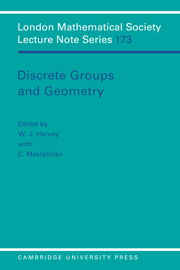Book contents
- Frontmatter
- Contents
- Preface
- Symmetries of modular surfaces
- Lifting group actions to covering spaces
- A combinatorial approach to the symmetries of M and M–l Riemann surfaces
- Inequalities for Pell equations and Fuchsian groups
- The Euler characteristic of graph products and of Coxeter groups
- Infinite families of automorphism groups of Riemann surfaces
- Planar hyperelliptic Klein surfaces and fundamental regions of NEC groups
- An example of an infinite group
- Moduli of Riemann surfaces with symmetry
- Modular groups – geometry and physics
- On automorphisms of free products
- The growth series of the Gieseking group
- Exceptional representations of PSL2(q) of monodromy genus zero
- On the rank of NEC groups
- The geometry of bending quasi-Fuchsian groups
- Farey series and sums of continued fractions
- Commensurability classes of two-generator Fuchsian groups
- Limit points via Schottky pairings
- Diagonalizing Eisenstein series III
- Some remarks on 2-generator hyperbolic 3-manifolds
- Uniformization, graded Riemann surfaces and supersymmetry
- Generating sets for finite groups
- Group actions on trees with and without fixed points
On automorphisms of free products
Published online by Cambridge University Press: 10 December 2009
- Frontmatter
- Contents
- Preface
- Symmetries of modular surfaces
- Lifting group actions to covering spaces
- A combinatorial approach to the symmetries of M and M–l Riemann surfaces
- Inequalities for Pell equations and Fuchsian groups
- The Euler characteristic of graph products and of Coxeter groups
- Infinite families of automorphism groups of Riemann surfaces
- Planar hyperelliptic Klein surfaces and fundamental regions of NEC groups
- An example of an infinite group
- Moduli of Riemann surfaces with symmetry
- Modular groups – geometry and physics
- On automorphisms of free products
- The growth series of the Gieseking group
- Exceptional representations of PSL2(q) of monodromy genus zero
- On the rank of NEC groups
- The geometry of bending quasi-Fuchsian groups
- Farey series and sums of continued fractions
- Commensurability classes of two-generator Fuchsian groups
- Limit points via Schottky pairings
- Diagonalizing Eisenstein series III
- Some remarks on 2-generator hyperbolic 3-manifolds
- Uniformization, graded Riemann surfaces and supersymmetry
- Generating sets for finite groups
- Group actions on trees with and without fixed points
Summary
Introduction
Whitehead [8] represented elements of a free group by embedding surfaces in an orient able 3-manifold and represented the action of an automorphism by changing the surfaces. Combinatorial versions of his results were given by Rapaport [7] and by Higgins and Lyndon [3]. These were further developed by McCool [6] and a graphical version of his results is given in [4]. More recently Whitehead's work was extended by Gersten [2] to subgroups of a free group and by Collins and Zieschang [1] to elements of a free product.
In this paper we prove the Peak Reduction theorem of [1] for subgroups of a free product. The notation used differs slightly from that in [1] for reasons that will be apparent. We use a concept from [2] and an action by automorphisms on coset graphs similar to that in [5] and dual to that in [4]. This action is also similar to some ideas of Wicks [9]. The authors are grateful to Don Collins for useful comments and criticisms.
Preliminaries
Let G be a group with identity e. Let X be a set of generators for G closed under taking inverses. If H is a subgroup of G then the based coset graph (Γ, H) has for vertices the right cosets of H, with H itself being the base vertex, and has for each x in X a directed edge labelled x joining K to Kx for each coset K.
- Type
- Chapter
- Information
- Discrete Groups and Geometry , pp. 104 - 119Publisher: Cambridge University PressPrint publication year: 1992



